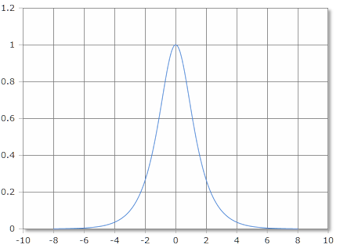Hyperbolic Secant
Online calculator for calculating the hyperbolic secant of an angle
Sech Calculator
Universal Domain
The Sech(x) or hyperbolic secant shows bell curve behavior for all real numbers.
Sech Function Curve

The Sech function forms a bell curve with maximum value 1 at x = 0.
Domain: ℝ, Range: (0, 1]
|
|
Bell Curve Behavior of Sech
The hyperbolic secant function exhibits characteristic bell curve properties:
- Domain: ℝ (all real numbers)
- Range: (0, 1] (values between 0 and 1)
- Maximum: Sech(0) = 1
- Reciprocal: Sech(x) = 1/Cosh(x)
- Symmetry: Even function Sech(-x) = Sech(x)
- Shape: Classic bell curve (soliton profile)
Exponential Representation of Sech Function
The hyperbolic secant function is expressed through exponential functions:
Basic Formula
Reciprocal of hyperbolic cosine
Soliton Relation
Classic soliton pulse shape
Formulas for the Sech Function
Definition
Reciprocal of hyperbolic cosine for all x ∈ ℝ
Soliton Equation
Traveling wave solution (soliton pulse)
Derivative
Derivative involves both secant and tangent
Symmetry Property
Even function (symmetric about y-axis)
Asymptotic Behavior
Bell curve with maximum at origin
Special Values
Important Values
Universal Domain
Function defined everywhere
Maximum Value
Maximum value is 1 at x = 0
Properties
- Even function
- Bell curve shape
- Bounced between 0 and 1
- Soliton profile
Reciprocal Relation
Perfect reciprocal of hyperbolic cosine
Applications
Soliton theory, nonlinear optics, signal processing, probability theory.
Detailed Description of the Sech Function
Definition and Input
The hyperbolic secant function Sech(x) is the reciprocal of the hyperbolic cosine function. It exhibits characteristic bell curve behavior and is fundamental in soliton theory and nonlinear wave physics.
Input
The angle is given in degrees (full circle = 360°) or radians (full circle = 2π). The unit of measurement used is set using the Degrees or Radians menu. All real numbers are valid inputs.
Result
The result is always between 0 and 1, with the maximum value of 1 occurring at x = 0. The function decreases exponentially as |x| increases.
Using the Calculator
Enter any angle value. The Sech function calculates the hyperbolic secant, which represents the classic soliton pulse shape.
Mathematical Properties
Function Properties
- Domain: ℝ (all real numbers)
- Range: (0, 1] (bounded positive values)
- Maximum: Sech(0) = 1
- Symmetry: Even function Sech(-x) = Sech(x)
Bell Curve Properties
- Classic bell shape (soliton profile)
- Maximum at origin, decreasing symmetrically
- Exponential decay for large arguments
- Bounded between 0 and 1
Applications
- Soliton Theory: Pulse propagation in optical fibers
- Nonlinear Optics: Self-focusing phenomena
- Signal Processing: Pulse shape analysis
- Probability Theory: Bell-shaped distributions
Practical Notes
- No domain restrictions: accepts any real number
- Bounded output: 0 < Sech(x) ≤ 1 for all x
- Even function: Sech(-x) = Sech(x)
- Bell shape: Classic soliton pulse profile
Calculation Examples
Central Values
Sech(0) = 1
Sech(1) ≈ 0.648
Sech(2) ≈ 0.266
Special Values
Sech(ln(2)) = 0.8
Sech(ln(3)) ≈ 0.6
Sech(π) ≈ 0.086
Large Arguments
Sech(5) ≈ 0.0135
Sech(10) ≈ 9.1e-5
Exponential decay
Soliton and Nonlinear Applications
Soliton Theory
Pulse Shape:
u(x,t) = A·Sech(k(x-vt))
Self-preserving wave pulse
Application: Optical fiber communication systems.
Nonlinear Optics
Self-Focusing:
Kerr effect in optical media
Bright soliton solutions
Example: Pulse propagation in nonlinear crystals.
Important Mathematical Relationships
Reciprocal Function Properties
Reciprocal Relationship: Perfect inverse of hyperbolic cosine.
Calculus Properties
Derivative: Product of secant and tangent.
|
|
|
|